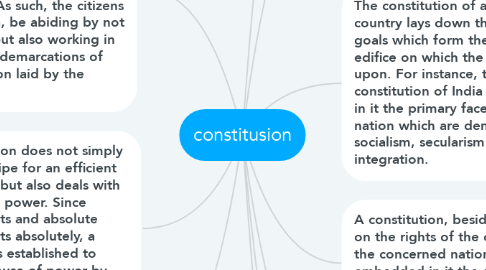constitusion
by Delnaaz Maneckji

1. The primary function of a constitution is to lay out the basic structure of the government according to which the people are to be governed. It is the constitution of a country, which establishes the three main organs of the government, namely, the legislature, executive and judiciary.
2. The constitution of a country not only defines the powers allotted to each of the three main organs, but it also significantly makes a clear demarcation of the responsibilities assigned to each of them. It effectively regulates the relationship between these organs as well as the relationship between the government and its people.
3. Since the country’s constitution stands superior to all the laws framed within the territorial precincts of the country, any law enacted by the ruling government has to be in conformity with the concerned constitution. As such, the citizens would, in turn, be abiding by not just the law, but also working in sync with the demarcations of the constitution laid by the country.
4. The constitution does not simply provide a recipe for an efficient government, but also deals with limitations on power. Since power corrupts and absolute power corrupts absolutely, a constitution is established to restrict the abuse of power by those who conduct governmental functions.
5. The constitution of a particular country lays down the national goals which form the basic edifice on which the nation rests upon. For instance, the constitution of India has inscribed in it the primary facets of the nation which are democracy, socialism, secularism and national integration.
6. A constitution, besides thrusting on the rights of the citizens of the concerned nation, also has embedded in it the duties that the citizens require to adhere to as well.
7. The constitution was a hand written document, and not typed and printed, with as much as 48 articles, 12 schedules and 94 amendments.
8. Indian constitution2. A total of 283 members of the constituent assembly signed the constitution, which came into being on 26th January, 1950.
9. 3. The Indian constitution is the longest in the world.
10. 4. It took around 2 years, 11 months and 17 days for the assembly to finish writing the entire constitution. And there you go again; writing to its length!


